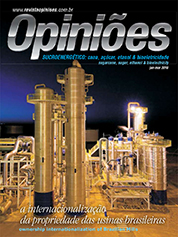Paulo Guilherme de Menezes Coimbra
Corporate Finance Director of KPMG in Brazil
Op-AA-23
The scenario is the continued consolidation process
In the past decade, the sugar-based energy industry experienced significant changes. Among them, strong growth in the production of sugarcane and ethanol, due to the increase in the number of “flex-fuel” vehicles, which are expected to represent more than 50% of the Brazilian fleet by 2013. On top of that, in some regions, ethanol already sells more than gasoline.
The use of ethanol is also becoming more important around the world as an alternative energy source for oil and is standing out in the international scenario, in which many countries are developing programs to mix ethanol with gasoline, in association with environmental policies. The use of biofuel is expected to grow significantly by 2020, which is a positive factor for the Brazilian economy, given that ethanol is the biofuel with the most attractive cost and Brazil is the most competitive country with respect to cost and technology.
One should also emphasize the intensive consolidation movement in the sugar-based energy industry and the investments being made in greenfield projects. Ethanol, as an alternative source, is arousing much interest in local and international investors in Brazil, whether in the form of mergers and acquisitions or greenfield projects.
Almost daily, one finds news about large oil companies, construction companies or trading companies in connection with mergers, acquisitions or joint ventures, informing of their interest in investing in the industry. A good thermometer to assess the movement in the industry and its attractiveness, are mergers and acquisitions.
Between 2001 and 2006, the number of transactions among mills varied between five and ten per year. In 2007, M&As peaked, at a historical record number of 25 deals. Notwithstanding these positive results, the financial crisis in 2008 prevented an acceleration of the sugar and ethanol industry consolidation movement.
In 2008, the number of mergers decreased to 14, already having reflected the beginning of economic turbulence, and in 2009, the decrease was even more significant, with only 12 transactions among mills having taken place. However, one can state that the transactions concluded in 2009 were bigger than the historical average and that the industry went into a recession, albeit milder than the average, having been responsible for 2.6% of total transactions in 2009, in comparison with 2,1% in 2008.
When the analysis is done considering the participation of international companies in total M&As, it shows that the figure is growing each year, increasing from approximately 40% between 2003 and 2006, to 76% in 2007 (19 transactions). By the same token, in 2008 and 2009, with eight transactions in each year, growth was, respectively, 57% and 75%.
Many local companies became targets of multinationals, but several of them view the moment as the right one for expansion opportunities, often in the form of partnerships. This type of transaction has been quite common in recent years and has been the origin of large groups. Furthermore, some international investors have an advantage over Brazilian groups, given the availability of cash for acquisitions, since Brazilian companies have high debt levels.
With respect to the profile of international investors, it is possible to find oil, food, trading, energy, private equity, construction and other companies. Another topic that should be considered in the market is the movement of Brazilian companies making acquisitions outside Brazil, also contributing to the internationalization of the industry and showing Brazil’s vocation in some important industries, such as oil and gas and mining, in which Brazilian companies were the object of acquisition processes by international players, grew strong and started making acquisitions.
Another important aspect is that the consolidation trend is changing the industry profile. When one assesses the main market players one can see the increase in production and market share in recent harvests. In light of all these indicators, one can state that the scenario for the industry, in coming years, is of continuity in the consolidation process, with the presence of global players.




